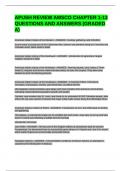Exam (elaborations)
APUSH REVIEW AMSCO CHAPTER 1-13 QUESTIONS AND ANSWERS (GRADED A)
- Course
- Institution
APUSH REVIEW AMSCO CHAPTER 1-13 QUESTIONS AND ANSWERS (GRADED A)APUSH REVIEW AMSCO CHAPTER 1-13 QUESTIONS AND ANSWERS (GRADED A)APUSH REVIEW AMSCO CHAPTER 1-13 QUESTIONS AND ANSWERS (GRADED A)APUSH REVIEW AMSCO CHAPTER 1-13 QUESTIONS AND ANSWERS (GRADED A) American Indian Culture of the Western - ...
[Show more]



